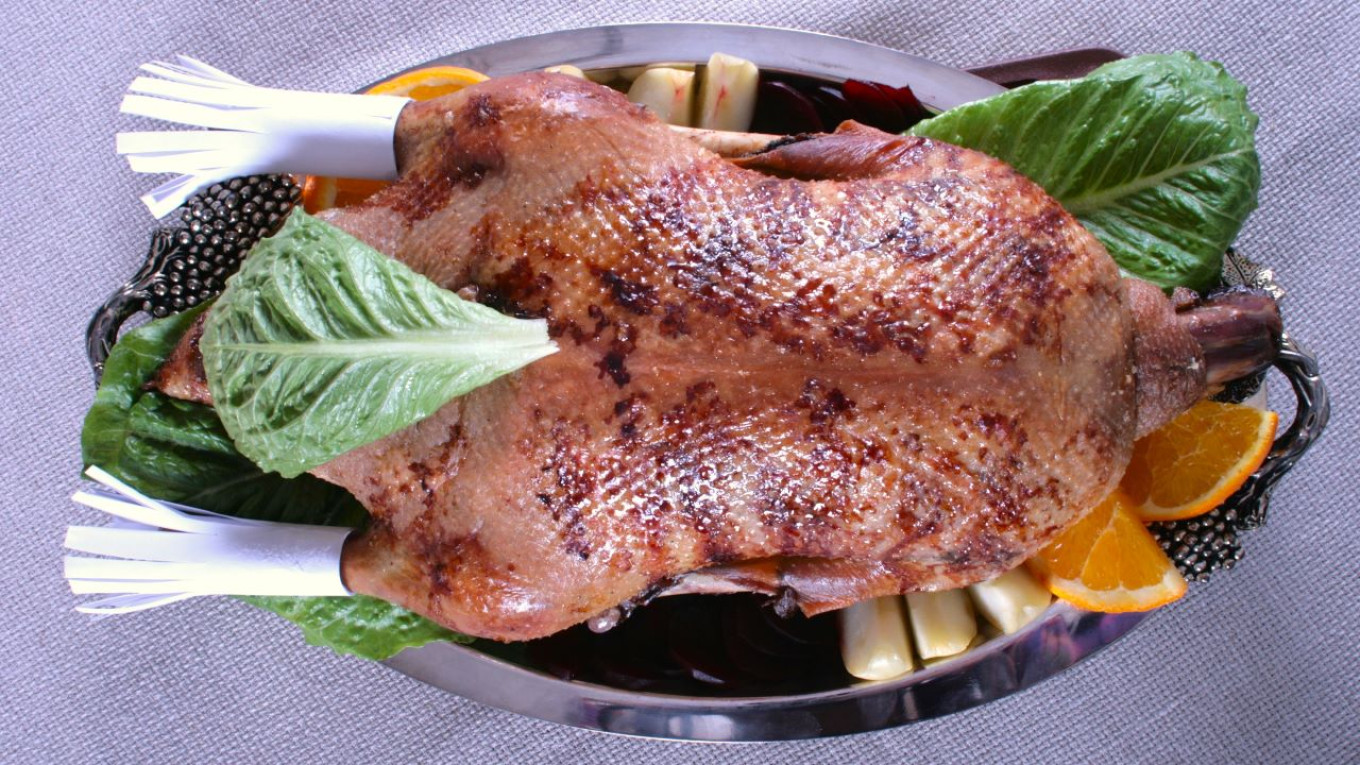There isn’t a single depiction of a holiday by a Russian artist without swans, ducks, and geese on the table. They are baked under a golden crust and decorated with feathers, lying in a bed of applies and little pies.
Or the swan is held aloft on a platter, floating above the heads of guests, who tear their eyes away from the beautiful bride to catch a glimpse of this rare delicacy. When you see these roasted birds, you know: it’s a real holiday!
Swans have been served on the Russian table since ancient times. Perhaps the earliest mention is in the “Tale of Igor’s Campaign,” written in the 12th century. Prince Igor, during his flight from captivity, “had geese and swans for breakfast, lunch and dinner.” If we search for an authoritative text, the first more or less reliable source about Russian cuisine was “Domostroi” (c.1550): “during the period when meat is eaten [the period without fasting] they serve swans, swan’s giblets, cranes, herons, ducks…”
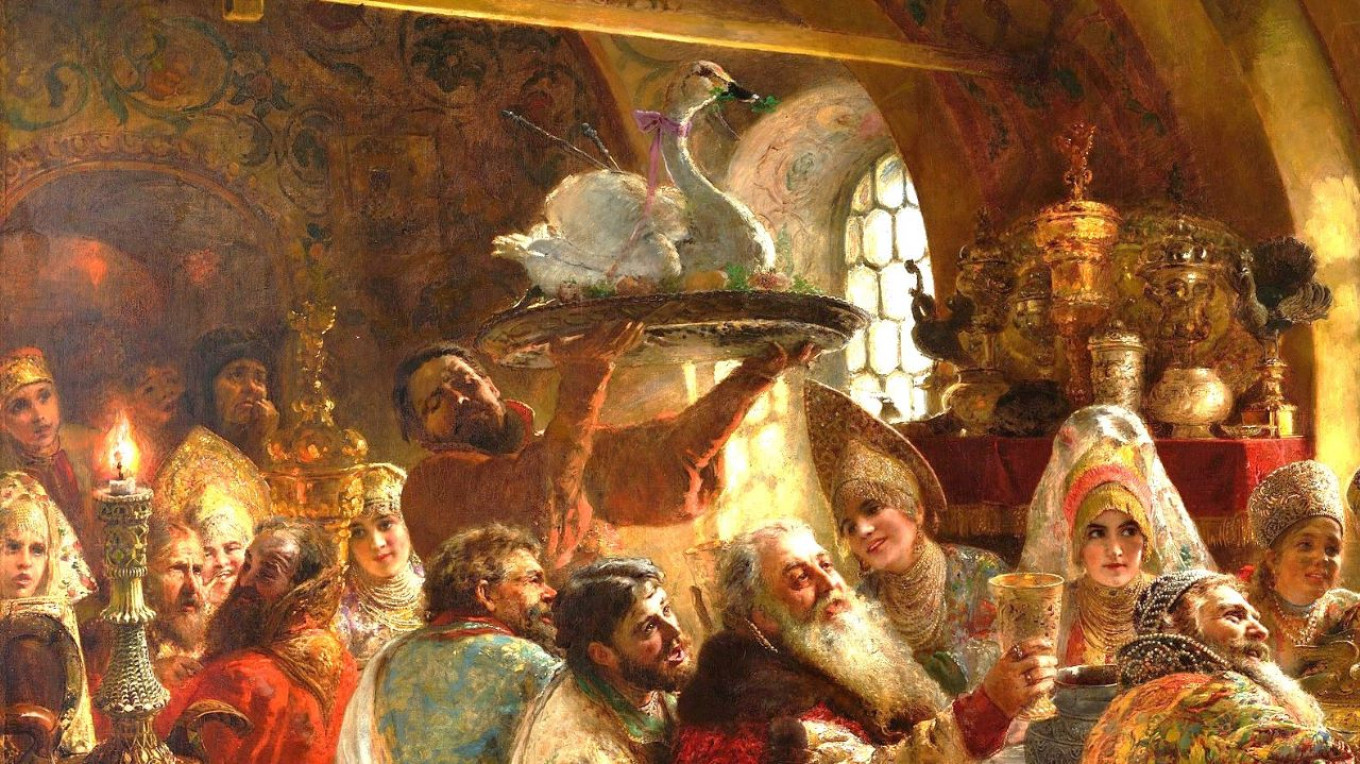
Today when we only see a live swan on the lake in a park, it’s impossible to imagine the abundance of game in our ancient past. The Russian historian Alexander Tereshenko (1848) wrote that “so many wild birds arrive in the spring that the fields and rivers are covered with them. In Saratov and Astrakhan provinces, the entire territory of 400 versts (about 265 miles) is covered by wild geese, ducks, partridges, quail, swans, cranes, bustards, black grouses, snipe, woodpeckers and other birds… They devour the crops and completely ruin the farmers.”
But even in that exuberant era, swans were considered an exquisite delicacy. They were served with slices of round rolls dipped in melted butter. Swan giblets were served in a “honey broth,” sometimes together with boiled beef or in pies. But the culinary secrets of medieval Russian cuisine were already lost by the 19th century. Sergei Aksakov, the author of the famous book “Notes of a Hunter,” was perplexed. “I do not understand why the swan was considered in the old days a delicacy or a holiday dish by our great princes and even tsars. They probably knew the art of making its meat tender, and the idea that the swan was just a table ornament must not be true.”
Today we can only guess that in the olden days the bird was marinated in a sauce or sour milk and then cooked in a Russian oven, which made the meat acquire a special flavor. In the uniform heat of a Russian stove, the swan was more stewed than roasted over an open fire. Perhaps that is why the swan meat remained juicy and tender.
However, ancient habits do not disappear without a trace. Although Vasily Levshin’s “Cook’s Dictionary” published 1795-98 no longer contains any swan recipes, it does give a glimpse into the past. “Crane are roasted on a spit, turned or not. If the crane is old and is not tenderized enough while roasting, the roasted meat can be used to make a perfectly delicious and nutritious stew.”
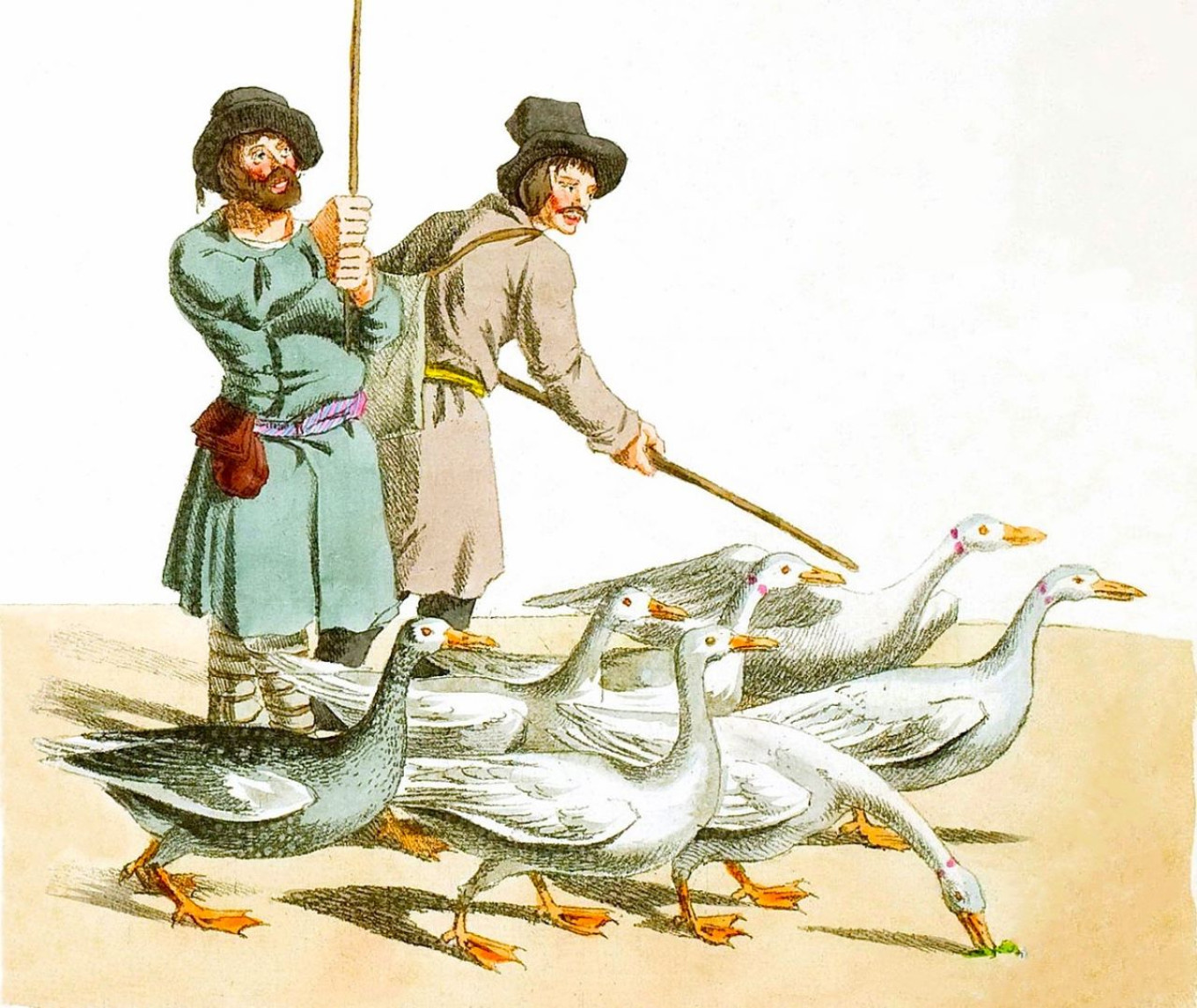
Nineteenth-century cuisine inherited these customs from our ancestors and made them simpler, yet more elegant. In the old days, no Christmas meal in our capital cities was without a roast goose. Our Food magazine writes how in 1893 tens of thousands of frozen geese were brought to St. Petersburg in December from the Simbirsk, Penza and Nizhny Novgorod provinces. Two weeks before the holidays, the railroad switched to a special schedule, freeing up tracks for “poultry” trains. Wagons with geese, ducks and turkeys arrived in the city: 10-15 wagons from every homestead with 100 birds on a wagon. Large industrial farms supplied 10-12,000 geese, earning their annual profit in the holidays alone.
In the preface to the “Almanac of Gastronomes” in 1852 Ignaty Radetzky wrote: “In food we find the only luxury that will never bore us throughout our lives.” Among these luxuries there are dozens of original dishes of game birds: vol-au-vents of hazel grouse, starlings stuffed with picante (hot sauce), gratin of wild game livers, sauté of goose livers with truffles.
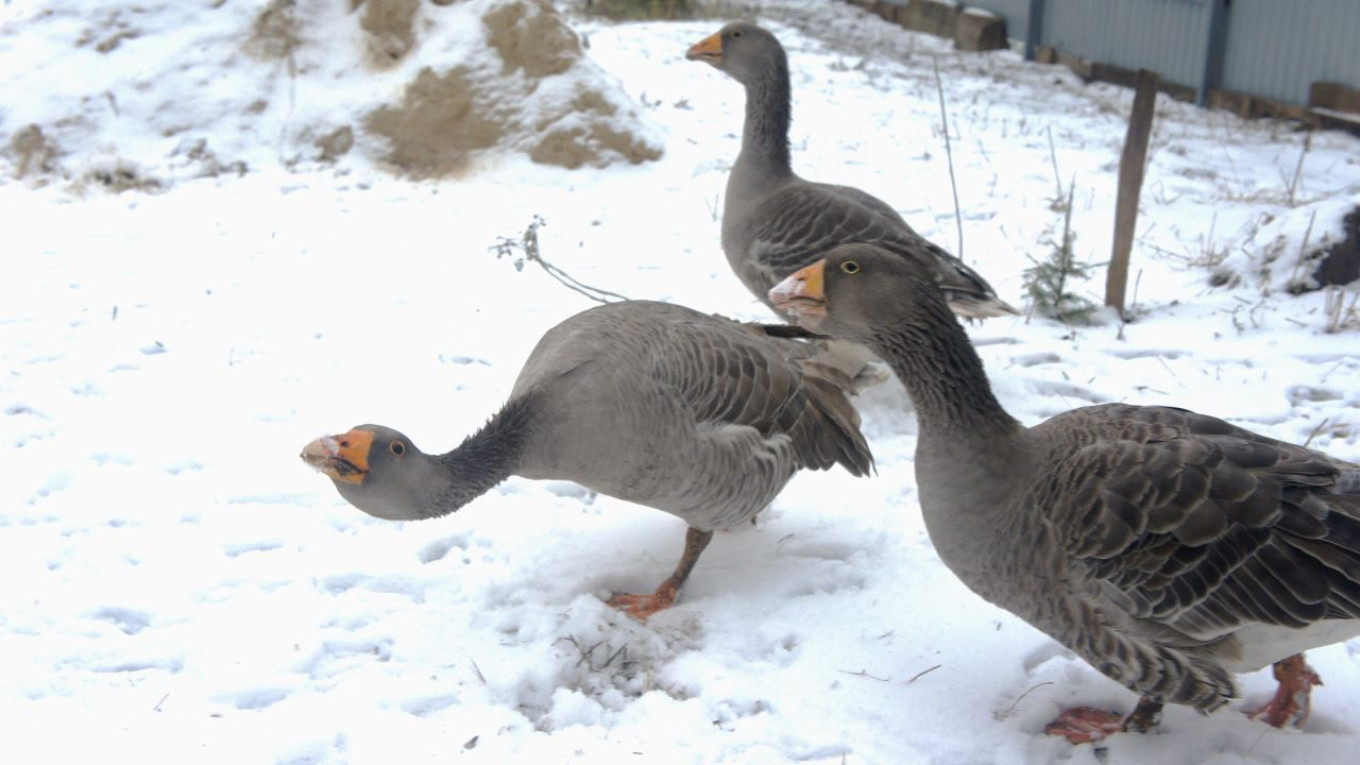
However, fancy names hide very simple dishes. For example, “Canards braises, aux navets” means simply “Duck with turnips” and is made as follows: “Roast the ducks on a spit, when they are half done, take them off the fire, cut them into portions and put them in a large pot. Chop up young turnips and deep fry them in boiling oil; then sprinkle with sugar. Transfer them from the oil to the pot with the duck pieces, cover with red sauce and cook over a low heat.”
All you need to know is that French red sauce is a brown meat broth made from roasted bones with the addition of sour cream, cream, and various spices, and then you see that you could fairly easily prepare such an exquisite dish even today.
And yet, the main dish on the Christmas table, even at the end of the 19th century, is still “goose.” We put this word in quotation marks, because “Christmas goose” in those days was any kind of roasted poultry: bustard, grouse, turkey, and even hazel grouse. It was the goose that became a symbol of the Christmas and New Year’s table for the well-to-do Russian public along pork roasts and ham.
We can’t say for certain if these recipes were part of everyday cooking. But then holiday recipes today are not “everyday dishes” either. Soon grouse and quail will disappear into the past, replaced by Pressed Fried Chicken (chicken tabaka) and Chicken with Rice for many decades of Soviet life.
Today nothing prevents us from celebrating Christmas with a goose on the table. And just like many generations of our ancestors, we prepare it with sauerkraut and prunes.
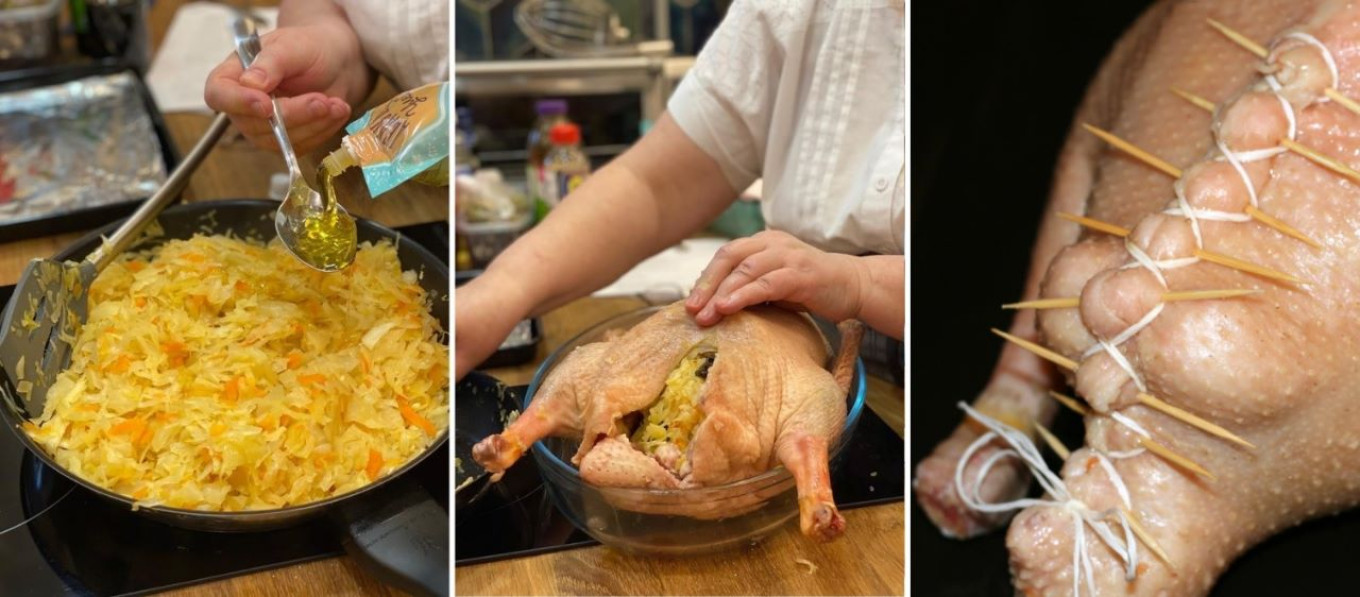
Goose with Sauerkraut and Prunes
Ingredients
- Goose
- 5 kg (6 ½ c) sauerkraut (preferably homemade)
- 15 pitted prunes
- 1 onion
- 30g (2 generous Tbsp) butter
- Salt, pepper
Instructions
- The goose must be prepared ahead of time. If the goose is frozen, it should be taken out of the freezer and put in the refrigerator on Dec. 21 or 22. The amount of time in the refrigerator depends on how frozen the goose is and the temperature of the refrigerator. It can take from one to two days to thaw. On Dec. 23, the goose should be ready for marinating.
- Cut off two wing joints and the neck (usually it is very long), but don’t throw them away! You can make a good broth with them. Cut off excess fat, but don’t throw that away either; it will be used to rub the skin.
- Rub the inside and outside of the goose with salt and black pepper. Put it in a bowl with a cover, wrap it in cling-film, or put in a plastic bag, and then put it back into the refrigerator.
- On Christmas day, 3-4 hours before cooking, take the goose out of the refrigerator and warm it to room temperature.
- While the goose warms up, chop the onion and mix with the sauerkraut. Melt the butter in a pot and add the mixture; let it all stew over a low flame for 40 minutes. Add the prunes and mix.
- Turn the oven up to 210˚C (410˚F).
- Use a toothpick to pierce the skin of the bird without cutting the meat. Rub the skin of the goose with the reserved goose fat.
- Stuff the goose with the cabbage, onion and prune mixture. Sew up the goose with cooking thread or close it with toothpicks and put it to the oven. Cook for 15 minutes at high temperature, and then turn it down to 160˚C (320˚F) and let it roast until done. Every 20-25 minutes baste with the rendered fat and drippings. Plan on 40-45 minutes for each kilogram of bird. When the goose is done, turn off the oven and let it rest inside for another 20-30 minutes before serving.
